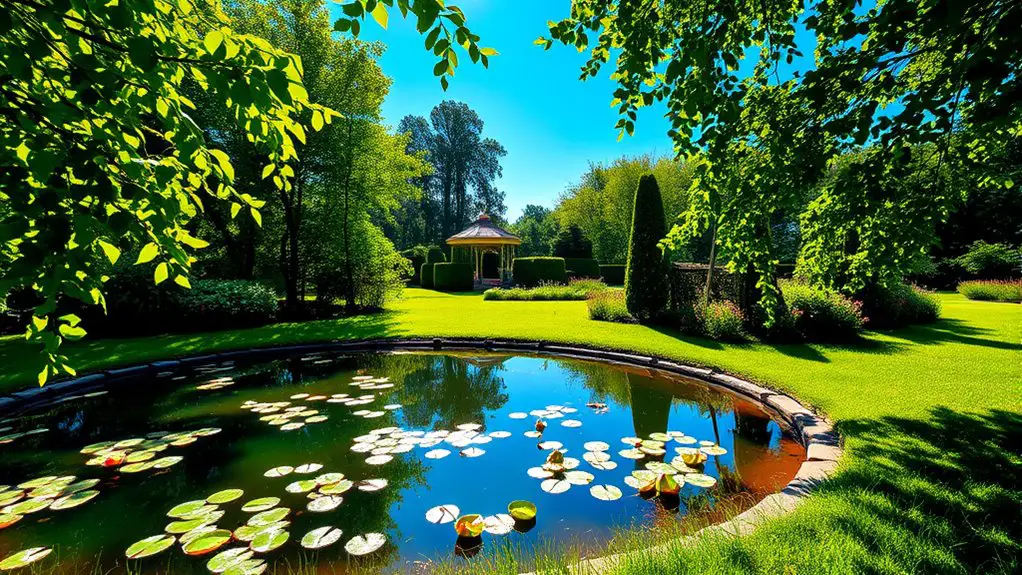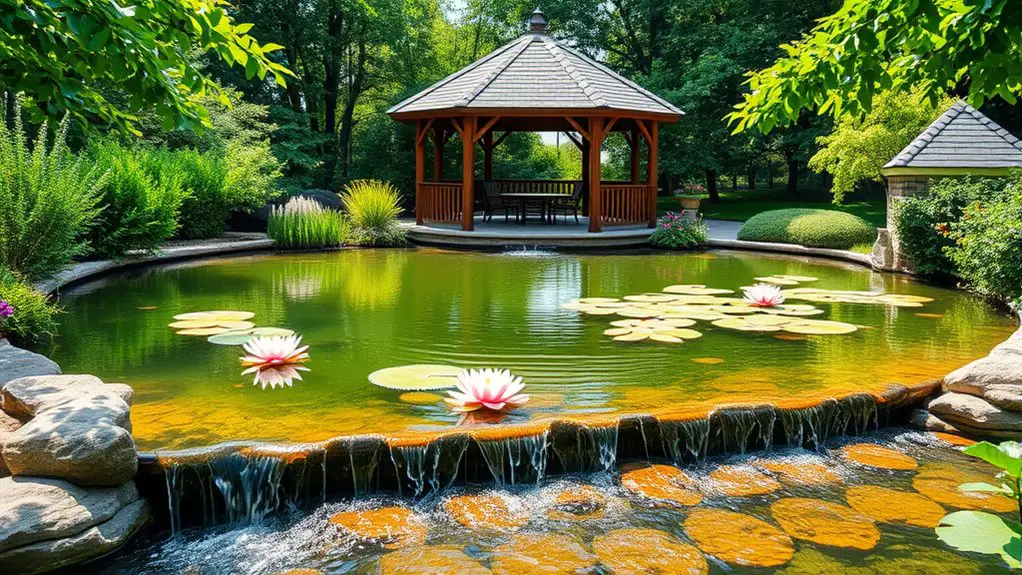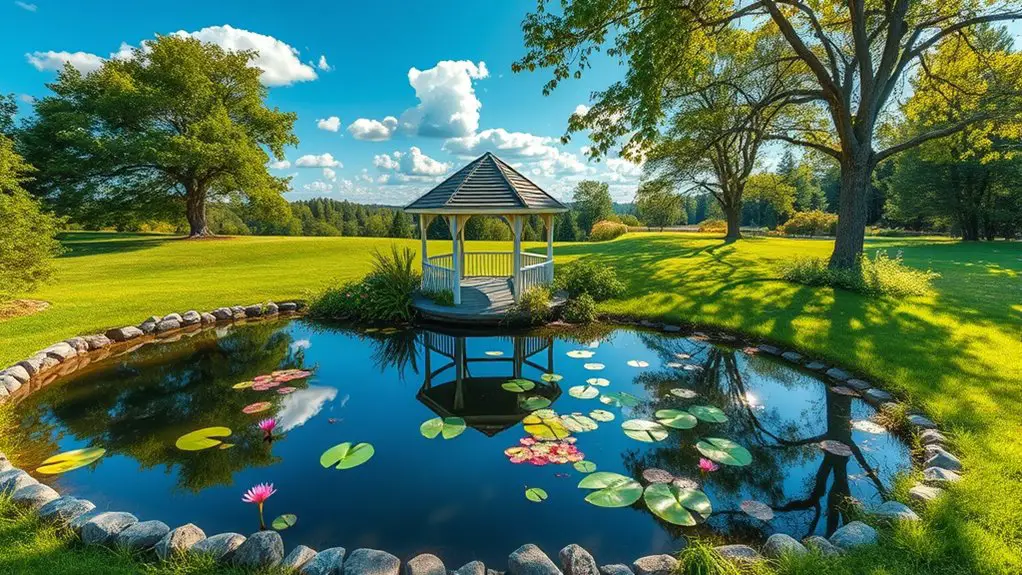To build a pond around your gazebo, first, choose a location with good drainage and existing water flow. Design a natural shape, incorporating varied depths for aquatic life. Excavate using suitable tools and install a pond liner for durability. Enhance your pond with aesthetic water features and water filtration systems. Select native plants for ecological balance and introduce fish to enrich the habitat. For a thriving ecosystem, follow proper maintenance tips, and discover additional insights to elevate your project.
Choosing the Perfect Location for Your Pond

When deciding where to place your pond, how do you guarantee it complements your gazebo while enhancing your landscape? Start by evaluating the existing water flow on your property. Ideally, your pond should sit in a location where natural runoff can feed it, creating a serene ecosystem. It’s essential to avoid areas with poor soil drainage, as standing water can lead to stagnation and unpleasant odors.
Consider the sightlines from your gazebo; you’ll want your pond to be a focal point, drawing the eye without overwhelming the space. Aim for a harmonious balance—positioning the pond close enough to enjoy its beauty, yet far enough to maintain a sense of privacy. Additionally, think about the surrounding flora; native plants can enrich your pond’s aesthetic while aiding in natural filtration. With thoughtful planning, your pond will become a tranquil retreat that seamlessly integrates with your gazebo and landscape.
Designing the Pond Layout
As you begin designing the layout of your pond, it’s important to take into account its shape and size in relation to your gazebo and the surrounding landscape. Consider a naturalistic pond shape, perhaps meandering around the gazebo, to create a seamless blend with nature. This organic form not only enhances aesthetics but also promotes a sense of freedom in your outdoor space.
Next, think about water depth. Varying depths can provide diverse habitats for aquatic life and create visual interest. Shallow areas can be perfect for plants, while deeper sections can support fish or serve as a cooling refuge. Aim for a depth of at least two feet in some spots to maintain a balanced ecosystem.
Excavation and Construction Basics

With the pond design in place, it’s time to focus on excavation and construction basics. Start by selecting the right excavation techniques; you can use a shovel for smaller areas or a backhoe for larger digs. The depth should vary, creating shelves for plants and deeper areas for fish.
Here’s a quick reference table for materials and tools:
| Material/Tool | Purpose |
|---|---|
| Shovel | Manual digging |
| Backhoe | Heavy-duty excavation |
| Gravel | Base layer for stability |
| Landscape fabric | Prevents weed growth |
Once you’ve excavated, consider your construction materials. Natural stones or pre-formed pond liners can enhance aesthetics and functionality. Always verify your materials are suitable for aquatic environments, guaranteeing a thriving ecosystem around your gazebo. Happy building!
Installing a Pond Liner
When it comes to installing a pond liner, selecting the right material is essential for long-term durability and functionality. You’ll need to take into account options like EPDM or PVC, each offering distinct benefits for your unique setup. Once you’ve chosen your liner, using proper installation techniques guarantees a tight fit that minimizes leaks and maximizes the beauty of your pond.
Choosing the Right Material
A sturdy pond liner is essential for ensuring the longevity and health of your gazebo pond. When selecting the right material types, consider these key durability considerations:
- EPDM Rubber: This highly flexible option resists UV rays and extreme temperatures, making it a top choice for long-term durability.
- PVC Liners: Lightweight and easy to install, PVC liners offer decent longevity but may not withstand harsh weather as well as rubber.
- Butyl Rubber: Known for its stretchability and strength, this material is perfect for intricate pond shapes and can last up to 20 years.
- Polyethylene: Budget-friendly and versatile, though less durable, it’s suitable for smaller ponds but may require more frequent replacements.
Choose wisely, and your gazebo pond will thrive for years.
Proper Installation Techniques
To guarantee your pond liner performs effectively, proper installation techniques are essential. Start by verifying you’ve taken proper measurements of your pond’s dimensions. This will help you purchase the right amount of liner material, avoiding unnecessary waste. Once you’ve got your liner, lay it out gently in the pond, avoiding sharp objects that could puncture it. Create a smooth, even surface, and make sure it’s anchored with rocks or soil to prevent shifting. Consider incorporating drainage solutions, like a small channel, to manage overflow and maintain water levels. Finally, check for any wrinkles or air pockets, smoothing them out to ensure peak function. With these steps, you’ll create a resilient, beautiful pond that enhances your gazebo’s charm.
Adding Water Features and Filtration Systems

While creating a serene pond around your gazebo, incorporating water features and an efficient filtration system is crucial for maintaining the ecosystem’s health and aesthetic appeal. Here are some important elements to reflect on:
- Waterfall Features: Adding a waterfall not only enhances visual beauty but also aerates the water, promoting a healthier environment for fish and plants.
- Filtration Types: Choose between mechanical, biological, and UV filters to guarantee clean water. Each type serves a unique purpose in maintaining water clarity.
- Fountain Options: Incorporate a fountain for added movement and sound, which can create a tranquil ambiance while aiding in oxygenation.
- Lighting: Install underwater lights to illuminate your water features at night, enhancing the overall charm of your pond and gazebo setting.
Selecting Aquatic Plants for Your Pond
When selecting aquatic plants for your pond, you’ll want to contemplate various plant types that fit your design vision and ecosystem needs. Each plant has specific sunlight requirements and maintenance considerations that can impact your pond’s health and aesthetics. By understanding these factors, you can create a vibrant, thriving habitat around your gazebo.
Plant Types Overview
Selecting the right aquatic plants for your pond is essential for creating a balanced ecosystem that enhances the beauty of your gazebo. By incorporating native plant selection, you promote biodiversity and guarantee your pond thrives. Here are four types of aquatic plants to take into account:
- Floating Plants: They cover the water’s surface, providing shade and reducing algae growth.
- Submerged Plants: These oxygenators help maintain water clarity and support aquatic life.
- Emergent Plants: With roots in the water, they add vertical interest and attract wildlife.
- Marginal Plants: Growing at the water’s edge, they stabilize soil and create a seamless shift between land and water.
Embracing these aquatic plant benefits will create a vibrant environment around your gazebo.
Sunlight Requirements
Understanding the sunlight requirements of your chosen aquatic plants is crucial to their success and the overall health of your pond. Different plants thrive under varying conditions, so you’ll need to assess the sunlight exposure around your gazebo. Full sun-loving species, like water lilies, require at least six hours of direct sunlight daily. In contrast, others, such as ferns, prefer light shade, flourishing in softer illumination. Observing how sunlight shifts throughout the day will guide your selection. Consider placing taller plants on the pond’s edges to provide some shade for smaller species. Balancing these needs guarantees your aquatic garden remains vibrant and supports a diverse ecosystem, granting you the freedom to enjoy your serene retreat.
Maintenance Considerations
While you might be enthusiastic to fill your pond with vibrant aquatic plants, it’s vital to contemplate their maintenance needs to guarantee a thriving ecosystem. Selecting the right plants can enhance water quality and help with algae control, creating a balanced environment. Here are four key considerations to keep in mind:
- Plant Variety: Choose a mix of submerged, floating, and marginal plants for diversity.
- Growth Rate: Opt for slow-growing species to reduce frequent maintenance.
- Water Requirements: Confirm plants are suited to your pond’s depth and sunlight exposure.
- Seasonal Care: Be prepared for seasonal changes, including pruning and replanting as needed.
Introducing Fish and Other Wildlife
Once you’ve established your pond around the gazebo, it’s time to think about the aquatic life that will enhance its beauty and ecosystem. Consider introducing various fish species like koi, goldfish, or native minnows to add color and movement. These fish not only provide visual appeal but also contribute to the pond’s health by controlling algae growth.
To foster wildlife attraction, create a balanced environment with plants around the pond’s edge, offering shelter and breeding grounds. Native species, such as frogs and dragonflies, will thrive, attracting birds and other beneficial wildlife.
Be mindful of the ecosystem balance; avoid overstocking fish, which can lead to oxygen depletion. Regularly monitor water quality to guarantee a thriving habitat. By thoughtfully selecting fish and promoting biodiversity, you’ll create a vibrant, lively pond that complements your gazebo and invites nature right to your doorstep.
Landscaping Around Your Gazebo and Pond
As you plan the landscaping around your gazebo and pond, consider how the design can enhance both aesthetics and functionality. Aim for gazebo harmony by integrating the natural elements with your architectural features. Here are four key landscaping ideas:
- Native Plants: Choose local flora that thrives in your climate. This not only beautifies your space but also supports local wildlife.
- Pathways: Create winding paths using stones or mulch that guide visitors around the pond, connecting the gazebo to the landscape.
- Seating Areas: Incorporate benches or lounge chairs near the pond for relaxation, allowing you to enjoy the tranquil scenery.
- Water Features: Add small waterfalls or fountains to your pond landscaping to create soothing sounds, enhancing the overall ambiance around your gazebo.
Maintenance Tips for a Healthy Pond Environment
To guarantee a thriving pond environment that complements your gazebo, you’ll need to prioritize regular maintenance. Start by monitoring water quality; it’s essential for the health of aquatic life. Testing kits can help you keep track of pH, ammonia, and nitrate levels.
Pond aeration is another vital aspect. By ensuring proper oxygen levels, you’ll promote a balanced ecosystem. Here’s a quick reference table to guide your maintenance:
| Maintenance Task | Frequency |
|---|---|
| Water Quality Testing | Bi-weekly |
| Clean Filters | Monthly |
| Aeration Check | Monthly |
| Algae Control | As needed |
Frequently Asked Questions
What Permits Are Needed to Build a Pond Near My Property?
You’ll need to check local pond regulations and property boundaries before building. Often, permits are required for water features to guarantee compliance with environmental standards, so consulting your municipality’s guidelines is essential for your project’s success.
How Deep Should My Pond Be for Fish Survival?
For ideal fish survival, your pond depth should typically range from 3 to 6 feet, depending on fish species. This depth helps maintain stable temperatures and oxygen levels, ensuring a healthy aquatic environment for your fish.
Can I Install a Pond in a Small Backyard?
Yes, you can install a pond in a small backyard. Consider a small pond design that complements your backyard landscaping, enhancing your space while providing tranquility and a habitat for wildlife, all within your personal oasis.
What Is the Best Time of Year to Build a Pond?
Did you know that nearly 60% of pond installations occur in spring? It’s the ideal time for spring planting and setting up seasonal maintenance, ensuring your pond thrives beautifully throughout the warmer months ahead.
How Do I Prevent My Pond From Freezing in Winter?
To prevent your pond from freezing, consider pond insulation and maintain water circulation. Installing a heater or aerator can help, ensuring the water stays moving and insulated, creating a thriving habitat even in winter’s chill.

